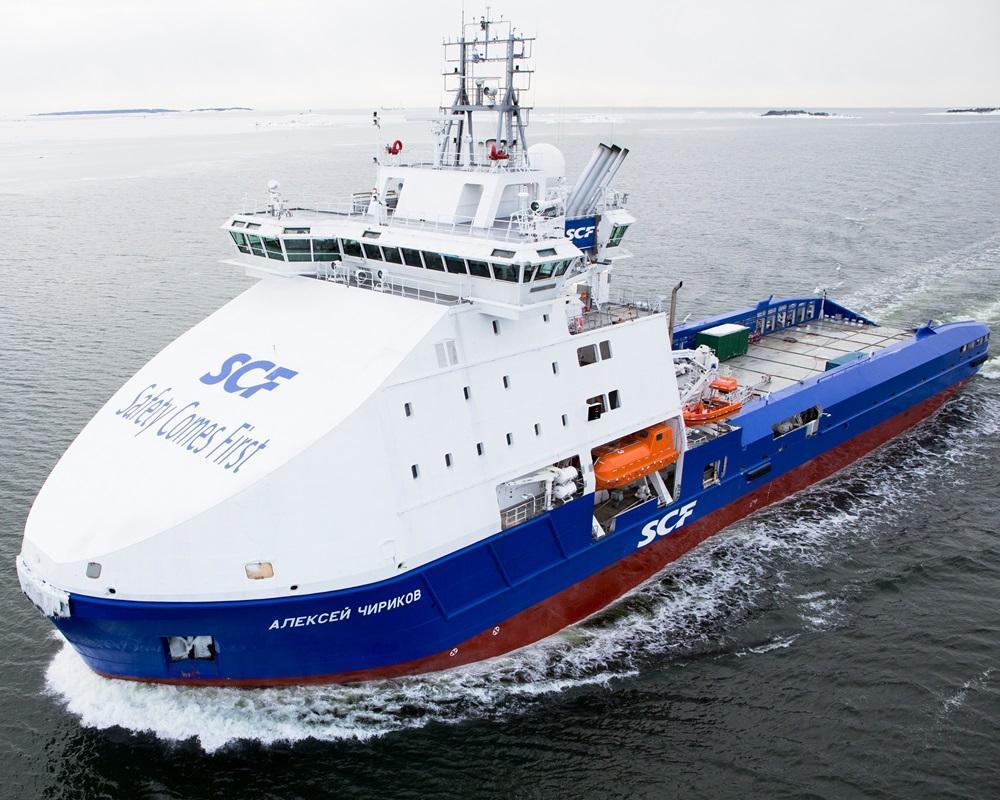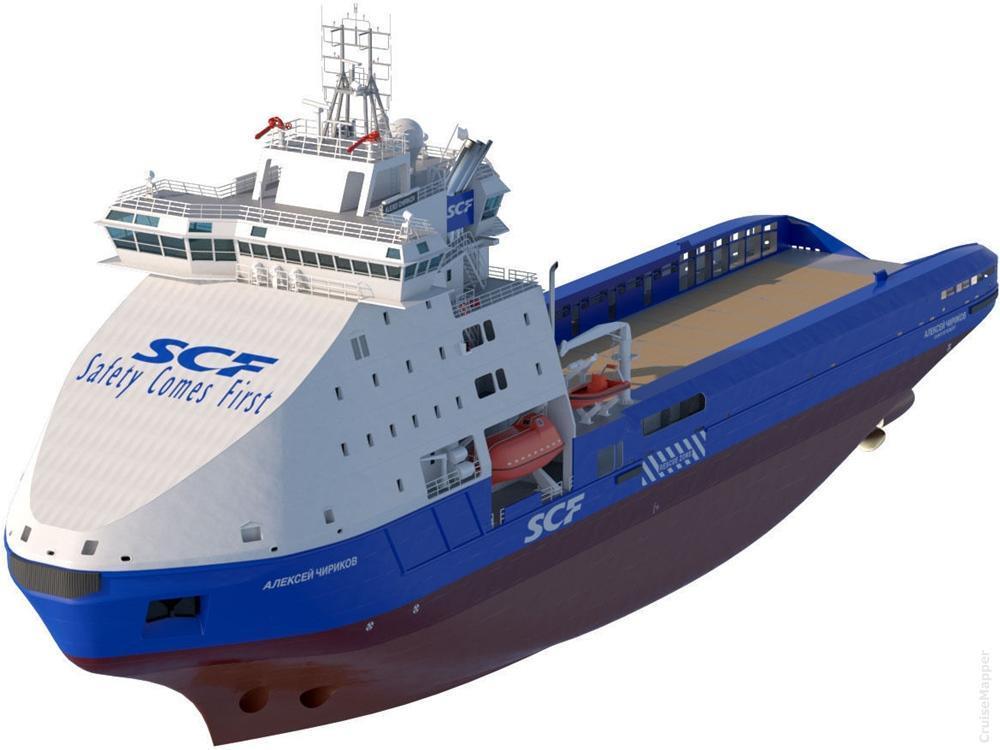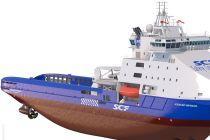Aleksey Chirikov icebreaker
Aleksey Chirikov icebreaker current position
The current location of Aleksey Chirikov icebreaker is in East Asia cruising en route to KHOLMSK. The AIS position was last reported 47 minutes ago.
Current PositionSpecifications of Aleksey Chirikov icebreaker
| Year of build | 2013 / Age: 12 |
| Flag state | Russia |
| Builder | Arctech Helsinki Shipyard (Helsinki, Finland) |
| Class | Icebreaking Supply Vessel |
| Ferry route / homeports | Vladivostok |
| Building cost | USD 100 million |
| Engines (power) | Wartsila (18 MW / 24138 hp) |
| Propulsion power | 15.6 MW / 20920 hp |
| Speed | 16 kn / 30 km/h / 18 mph |
| Length (LOA) | 100 m / 328 ft |
| Beam (width) | 22 m / 72 ft |
| Gross Tonnage | 7487 gt |
| Passengers | 28 |
| Crew | 22 |
| Sister-ships | Vitus Bering |
| Owner | SCF Sovcomflot (Russia) |
| Operator | SCF Sakhalin Vessels Ltd (Russia) |
Aleksey Chirikov icebreaker Review
Review of Aleksey Chirikov icebreaker
The 2013-built MS Vitus Bering ("ледокол Алексей Чириков") is an icebreaking vessel owned by SCF Sovcomflot (Совкомфлот/fleet) and operated through its subsidiary, SCF Sakhalin Vessels Ltd. The shipowner is a Russian state-owned corporation specializing in petroleum and LNG transportation.
The vessel (IMO number 9613551, Helsinki Shipyard/hull number 507) is currently flagged in Russia (MMSI 273369290) and homeported in Vladivostok.
The icebreaker operates as a supply vessel for Russia's Arkutun-Dagi Oil and Gas Field (part of the Sakhalin 1 project) in the Sea of Okhotsk, northwestern Pacific Ocean. The ship is named after Aleksei Ilyich Chirikov (1703–1748), a Russian navigator who, along with Vitus Bering, was among the first Russians to reach North America during the Great Northern Expedition (also known as the Second Kamchatka Expedition, 1733–1743). This expedition resulted in mapping much of Siberia's Arctic coast and parts of North America's coastline and islands.
History and Construction
This Russian icebreaker class was designed by Arctech Helsinki Shipyard (Helsinki, Finland) as a supply vessel, with sister ship Vitus Bering (built in 2012). Both ships were ordered on December 16, 2010, following a December 10 agreement between shipbuilders STX Finland (now Meyer Turku) and OCK (United Shipbuilding Corporation, Russia) to form the joint venture company "Arctech Helsinki Shipyard".

Sovcomflot ("Совкомфлот", founded in 1988) is Russia's largest shipping company, specializing in the transportation of hydrocarbons (including HGLs – hydrocarbon gas liquids) from Arctic regions. Of the fleet’s ~150 vessels, over 80 are ice-classed with icebreaking capabilities.
The shipbuilding contract for both icebreakers was valued at USD 200 million. Initially, both vessels were scheduled for delivery in April 2013. However, Vitus Bering was delivered earlier, on December 21, 2012. This class is an upgraded version of the 2005-built SCF Sakhalin.
Most of the hull blocks were assembled at the Arctech shipyard, with the majority manufactured in Russia by Vyborg Shipyard. Of the 42 hull blocks used across both ships, only five were made in Finland. The Russian-made blocks were transported by barge from Vyborg to the Arctech yard for outfitting, painting, and assembly.
The keel-laying ceremony for Aleksey Chirikov was held on January 3, 2012, in Helsinki—just three days after Vitus Bering’s float-out. During the ceremony, the first block (a 353-ton midship section) was lowered into the shipyard’s covered drydock. The vessel was floated out on November 23, 2012. Sea trials took place from March 19–23, 2013. The ship was officially delivered on April 19, 2013, and subsequently departed from Helsinki for St. Petersburg, Russia.
Aleksey Chirikov Icebreaker Vessel Details
The vessel is powered by four Wartsila marine diesel engines (generator sets): two 12-cylinder units (model 12V32, combined output 12 MW) and two 6-cylinder units (model 6L32, combined output 6 MW). The total power output is 18 MW (24,000 hp), providing electricity for all onboard systems.

The vessel features diesel-electric propulsion with two ABB Azipods (azimuth thrusters, model VI1600, total output 13 MW) and two bow thrusters (total output 2.6 MW).
- Maximum Draft: 8 m (26 ft) when fully loaded
- Deadweight: 4,158 tons
- Icebreaking capability: 1.7 m (6 ft) thick ice, both ahead and astern
- Icebreaking speed: 3 knots (5.6 kph / 3.5 mph) in 1.5 m (5 ft) thick ice
- Endurance: 30 days
- Ice class: Icebreaker6 (Russian Maritime Register of Shipping – RMRS)
- Cargo capacity: cargo deck (709 m²), bulk liquids (3,850 m³)
- Crew and passenger capacity: 50 (22 crew + 28 personnel)
- Firefighting capacity: 2 monitors (1,200 m³/hour each), water spray system (1,000 m³/hour)
- Rescue capacity: 195 people
Vessels of similar design but with enhanced specifications—featuring six engines (21 MW total power), expanded capacity (70 people), and a moon pool for diving support—include SCF’s icebreaking supply ships Gennadiy Nevelskoy, Fedor Ushakov, and Stepan Makarov.

Note: In areas with poor AIS coverage, tracking the vessel's current location may not be possible. You can find CruiseMapper’s complete list of icebreakers and icebreaking research vessels in the "itinerary" section of our Icebreakers hub, which includes fleet details for all operating countries.
Other SCF Sovcomflot Russia cruise ships
Aleksey Chirikov icebreaker Wiki
Other newbuild Russian icebreaking support vessels include Gazprom Neft's Alexander Sannikov (2018) and Andrey Vilkitsky (2018). Both vessels operate at Gazprom's Arctic Gate— the offshore crude oil loading terminal at the Novoportovskoye oil field.

